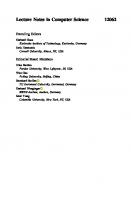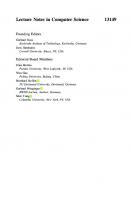Computer Animation and Social Agents: 33rd International Conference on Computer Animation and Social Agents, CASA 2020, Bournemouth, UK, October 13-15, 2020, Proceedings 9783030634254, 9783030634261
This book constitutes the revised selected papers of the 33rd International Conference on Computer Animation and Social
219 97 22MB
English Pages 137 [144] Year 2020
Table of contents :
Preface
Organization
Contents
Modelling, Animation and Simulation
ESENet: A Human Behavior Recognition Model Based on Extended Squeeze-and-Excitation Network
1 Introduction
2 Related Work
3 Methods
3.1 ESENet
3.2 The Integration of 3DSE and 3DCNN
4 Experiments and Analysis
4.1 The Details of Datasets and Our Experiment
4.2 The Ablation Study
4.3 Comparing 3DSE with SE
4.4 The Comparison to Other Approaches on Different Datasets
5 Conclusion
References
Interpolating Frames for Super-Resolution Smoke Simulation with GANs
1 Introduction
2 Related Work
3 Proposed Approach
3.1 Interpolating Frames
3.2 Slow Fusion
3.3 Loss Functions
4 Data Generation and Training
5 Results
6 Conclusions and Future Work
References
3D Face Reconstruction and Semantic Annotation from Single Depth Image
1 Introduction
2 Method
2.1 Coarse-Level Facial Code Inference
2.2 Fine-Level Displacement Inference
2.3 Semantic Annotation
2.4 Loss
3 Experiments
4 Conclusion
References
A Robot for Interactive Glove Puppetry Performance
1 Introduction
2 Related Work
3 Method
3.1 Robot
3.2 Interactive Performance
4 Experience
4.1 Performance Configuration
4.2 Interaction Sections in the Performance
4.3 Analysis
5 Conclusion
References
Virtual Reality
Efficient Metaballs-Based Collision Detection for VR Neurosurgery Simulation on GPU
1 Introduction
2 Related Work
3 Construction and Optimization of the Inner Metaballs
3.1 Initialization of the Inner Metaballs
3.2 Global Optimization Using the Electrostatic Attraction Model
4 Collision Detection and Response
4.1 Self and Multi-Organs' Collision
4.2 Adaptive Cylinder Based Collision Detection
4.3 Collision Response and Deformation
5 Experiments, Comparison, and Application
6 Conclusion and Discussion
References
Posing 3D Characters in Virtual Reality Through In-the-Air Sketches
1 Introduction
2 Related Works
3 Proposed System
3.1 VR-Based Environment for 3D Sketching
3.2 Matching and Aligning Algorithm
3.3 Current Development State
4 Conclusions and Future Work
References
Evaluating the Need and Effect of an Audience in a Virtual Reality Presentation Training Tool
1 Introduction
2 Related Work
2.1 VR as a Presentation Environment
3 The VR Presentation Environment
4 Experiment Design
4.1 Environment Metrics
4.2 Apparatus
4.3 Participants
4.4 Procedures
5 Results
5.1 Pre-questionnaire
5.2 Questionnaires of Nervousness and Preference Order
5.3 Open-Ended Questions
5.4 Discussion
6 Conclusion
References
Image Processing and Computer Vision
A Cascaded Approach for Keyframes Extraction from Videos
1 Introduction
2 Related Work
3 Method
3.1 Overview
3.2 Generating Initial Clips
3.3 Adaptive Window Length
3.4 Meaningless Frames Removal
3.5 Mapping and Optimization
4 Experiments
4.1 Experimental Setup
4.2 Quantitative Results
5 Conclusion
References
Extracting Highlights from a Badminton Video Combine Transfer Learning with Players' Velocity
1 Introduction
2 Related Work
3 The Proposed Method
3.1 Badminton Video Segmentation
3.2 Highlight Extraction
4 Experiment
4.1 Badminton Video Segmentation
4.2 Evaluation of Extracted Highlights
5 Conclusions
References
Dynamic Human Body Size Measurement Based on Feature Points Prediction and Mapping
1 Method
1.1 Random Forest Regression Analysis
1.2 3D Human Body Mapping
1.3 Measurement of Models
2 Experiment
2.1 Parameter Setting of Random Forest Regression
2.2 Correspondence Map
2.3 Measurement of 3D Human Models
3 Conclusion
References
Amur Tiger Re-ID Based on Locally Guided Adaptive Feature Fusion
1 Introduction
2 Related Work
3 Methodology
3.1 Partial Image
3.2 Locally Guided Adaptive Feature Fusion Network
3.3 Feature Fusion
3.4 Loss Function
4 Experiment
4.1 Dataset
4.2 Experiment Details
4.3 Experimental Results
5 Conclusion
References
MVFNN: Multi-Vision Fusion Neural Network for Fake News Picture Detection
1 Introduction
2 Related Works
3 The Proposed Model
3.1 Model Overview
3.2 Model Derivation
4 Experiments
4.1 Datasets
4.2 Baselines
4.3 Performance Comparison
4.4 Ablation Study
4.5 Multi-feature Fusion
5 Conclusion
References
PEFS: A Validated Dataset for Perceptual Experiments on Face Swap Portrait Videos
1 Introduction
2 Related Work
3 Dataset
4 Perceptual Validation
5 Conclusion
References
Altering the Conveyed Facial Emotion Through Automatic Reenactment of Video Portraits
1 Introduction and Related Work
2 Reenacting Technique
3 Experimental Design
4 Results and Discussion
5 Conclusion
References
Author Index
Preface
Organization
Contents
Modelling, Animation and Simulation
ESENet: A Human Behavior Recognition Model Based on Extended Squeeze-and-Excitation Network
1 Introduction
2 Related Work
3 Methods
3.1 ESENet
3.2 The Integration of 3DSE and 3DCNN
4 Experiments and Analysis
4.1 The Details of Datasets and Our Experiment
4.2 The Ablation Study
4.3 Comparing 3DSE with SE
4.4 The Comparison to Other Approaches on Different Datasets
5 Conclusion
References
Interpolating Frames for Super-Resolution Smoke Simulation with GANs
1 Introduction
2 Related Work
3 Proposed Approach
3.1 Interpolating Frames
3.2 Slow Fusion
3.3 Loss Functions
4 Data Generation and Training
5 Results
6 Conclusions and Future Work
References
3D Face Reconstruction and Semantic Annotation from Single Depth Image
1 Introduction
2 Method
2.1 Coarse-Level Facial Code Inference
2.2 Fine-Level Displacement Inference
2.3 Semantic Annotation
2.4 Loss
3 Experiments
4 Conclusion
References
A Robot for Interactive Glove Puppetry Performance
1 Introduction
2 Related Work
3 Method
3.1 Robot
3.2 Interactive Performance
4 Experience
4.1 Performance Configuration
4.2 Interaction Sections in the Performance
4.3 Analysis
5 Conclusion
References
Virtual Reality
Efficient Metaballs-Based Collision Detection for VR Neurosurgery Simulation on GPU
1 Introduction
2 Related Work
3 Construction and Optimization of the Inner Metaballs
3.1 Initialization of the Inner Metaballs
3.2 Global Optimization Using the Electrostatic Attraction Model
4 Collision Detection and Response
4.1 Self and Multi-Organs' Collision
4.2 Adaptive Cylinder Based Collision Detection
4.3 Collision Response and Deformation
5 Experiments, Comparison, and Application
6 Conclusion and Discussion
References
Posing 3D Characters in Virtual Reality Through In-the-Air Sketches
1 Introduction
2 Related Works
3 Proposed System
3.1 VR-Based Environment for 3D Sketching
3.2 Matching and Aligning Algorithm
3.3 Current Development State
4 Conclusions and Future Work
References
Evaluating the Need and Effect of an Audience in a Virtual Reality Presentation Training Tool
1 Introduction
2 Related Work
2.1 VR as a Presentation Environment
3 The VR Presentation Environment
4 Experiment Design
4.1 Environment Metrics
4.2 Apparatus
4.3 Participants
4.4 Procedures
5 Results
5.1 Pre-questionnaire
5.2 Questionnaires of Nervousness and Preference Order
5.3 Open-Ended Questions
5.4 Discussion
6 Conclusion
References
Image Processing and Computer Vision
A Cascaded Approach for Keyframes Extraction from Videos
1 Introduction
2 Related Work
3 Method
3.1 Overview
3.2 Generating Initial Clips
3.3 Adaptive Window Length
3.4 Meaningless Frames Removal
3.5 Mapping and Optimization
4 Experiments
4.1 Experimental Setup
4.2 Quantitative Results
5 Conclusion
References
Extracting Highlights from a Badminton Video Combine Transfer Learning with Players' Velocity
1 Introduction
2 Related Work
3 The Proposed Method
3.1 Badminton Video Segmentation
3.2 Highlight Extraction
4 Experiment
4.1 Badminton Video Segmentation
4.2 Evaluation of Extracted Highlights
5 Conclusions
References
Dynamic Human Body Size Measurement Based on Feature Points Prediction and Mapping
1 Method
1.1 Random Forest Regression Analysis
1.2 3D Human Body Mapping
1.3 Measurement of Models
2 Experiment
2.1 Parameter Setting of Random Forest Regression
2.2 Correspondence Map
2.3 Measurement of 3D Human Models
3 Conclusion
References
Amur Tiger Re-ID Based on Locally Guided Adaptive Feature Fusion
1 Introduction
2 Related Work
3 Methodology
3.1 Partial Image
3.2 Locally Guided Adaptive Feature Fusion Network
3.3 Feature Fusion
3.4 Loss Function
4 Experiment
4.1 Dataset
4.2 Experiment Details
4.3 Experimental Results
5 Conclusion
References
MVFNN: Multi-Vision Fusion Neural Network for Fake News Picture Detection
1 Introduction
2 Related Works
3 The Proposed Model
3.1 Model Overview
3.2 Model Derivation
4 Experiments
4.1 Datasets
4.2 Baselines
4.3 Performance Comparison
4.4 Ablation Study
4.5 Multi-feature Fusion
5 Conclusion
References
PEFS: A Validated Dataset for Perceptual Experiments on Face Swap Portrait Videos
1 Introduction
2 Related Work
3 Dataset
4 Perceptual Validation
5 Conclusion
References
Altering the Conveyed Facial Emotion Through Automatic Reenactment of Video Portraits
1 Introduction and Related Work
2 Reenacting Technique
3 Experimental Design
4 Results and Discussion
5 Conclusion
References
Author Index

- Author / Uploaded
- Feng Tian
- Xiaosong Yang
- Daniel Thalmann
- Weiwei Xu
- Jianjun Zhang
- Nadia Magnenat Thalmann
- Jian Chang
- Similar Topics
- Computers
![Computer Animation and Social Agents: 33rd International Conference on Computer Animation and Social Agents, CASA 2020, Bournemouth, UK, October 13-15, 2020, Proceedings [1st ed.]
9783030634254, 9783030634261](https://ebin.pub/img/200x200/computer-animation-and-social-agents-33rd-international-conference-on-computer-animation-and-social-agents-casa-2020-bournemouth-uk-october-13-15-2020-proceedings-1st-ed-9783030634254-9783030634261.jpg)
![Speech and Computer: 22nd International Conference, SPECOM 2020, St. Petersburg, Russia, October 7–9, 2020, Proceedings [1st ed.]
9783030602758, 9783030602765](https://ebin.pub/img/200x200/speech-and-computer-22nd-international-conference-specom-2020-st-petersburg-russia-october-79-2020-proceedings-1st-ed-9783030602758-9783030602765.jpg)



![Agents and Multi-Agent Systems: Technologies and Applications 2020: 14th KES International Conference, KES-AMSTA 2020, June 2020 Proceedings [1st ed.]
9789811557637, 9789811557644](https://ebin.pub/img/200x200/agents-and-multi-agent-systems-technologies-and-applications-2020-14th-kes-international-conference-kes-amsta-2020-june-2020-proceedings-1st-ed-9789811557637-9789811557644.jpg)
![Integer Programming and Combinatorial Optimization: 21st International Conference, IPCO 2020, London, UK, June 8–10, 2020, Proceedings (Lecture Notes in Computer Science, 12125) [1st ed. 2020]
3030457702, 9783030457709](https://ebin.pub/img/200x200/integer-programming-and-combinatorial-optimization-21st-international-conference-ipco-2020-london-uk-june-810-2020-proceedings-lecture-notes-in-computer-science-12125-1st-ed-2020-3030457702-9783030457709.jpg)
![Advances in Computer Graphics: 37th Computer Graphics International Conference, CGI 2020, Geneva, Switzerland, October 20–23, 2020, Proceedings [1st ed.]
9783030618636, 9783030618643](https://ebin.pub/img/200x200/advances-in-computer-graphics-37th-computer-graphics-international-conference-cgi-2020-geneva-switzerland-october-2023-2020-proceedings-1st-ed-9783030618636-9783030618643.jpg)
![Computer Animation [1 ed.]
9781502601070, 9781502601063](https://ebin.pub/img/200x200/computer-animation-1nbsped-9781502601070-9781502601063.jpg)
